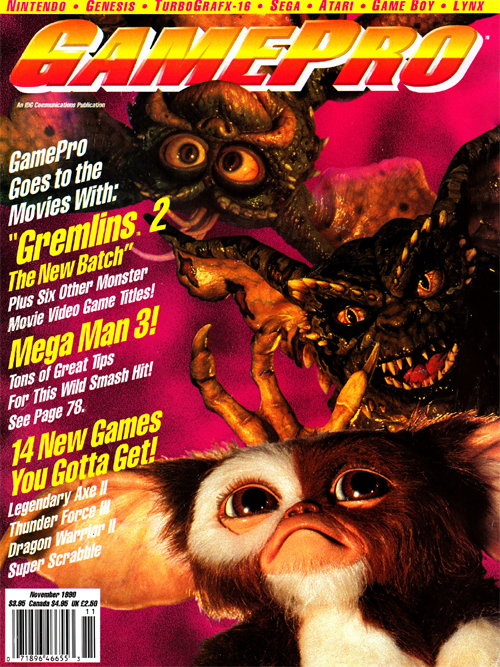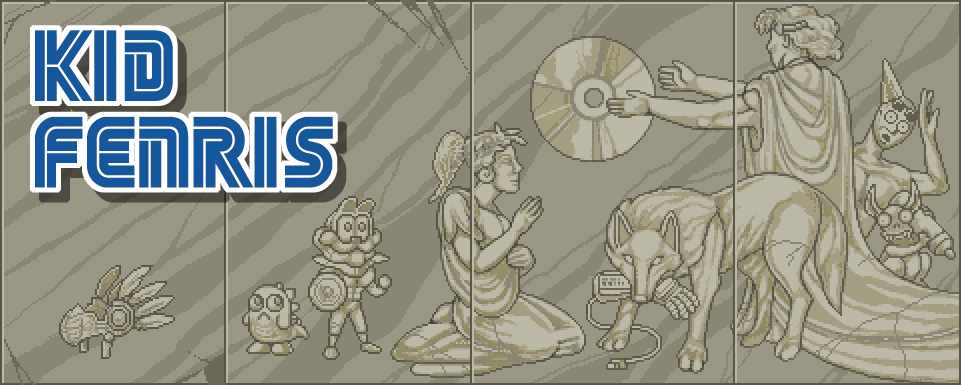GamePro wasn’t the first game magazine I read, but it was the first one I outgrew. I wasn’t alone in this. GamePro pitched squarely to the younger crowd with its goofy puns, colorful layouts, and tendency to say nice things about any game that did not immediately and irreparably blind the player. Even today, the original early ‘90s GamePro inspiries jokes about those softballed ProTips and a rating system of excited faces.
Well, I’ve changed my mind on GamePro. It’s now a fascinating document of its era. For one thing, I enjoy how sure-footed a magazine it is. Unlike the other mags of the early 1990s, GamePro knew exactly what it wanted to be, from its corny wordplay to its neon splashes, and its kid-focused editorial voice is nothing if not consistent. Video games were in a juvenile but charming place back then, and GamePro captures that better than any other publication.

The first GamePro I ever read was the November 1990 issue. I initially wanted it for the Mega Man 3 preview, but a better reason emerged: my mother didn’t like it. She didn’t care for the Gremlins on the cover, but she couldn’t come up with a specific argument as to why I couldn’t get it. Gizmo and Daffy weren’t really objectionable; they were just hideous. And I was just old enough to want anything my parents didn’t.
Yet there’s nothing remotely threatening in this GamePro. Even the Gremlins 2 coverage is part of a broad feature on movie-based games, including Dirty Harry, Days of Thunder, and Total Recall. Most of these games are terrible, and GamePro is diplomatic as ever, telling us that LJN’s dreadful Back to the Future II and III “doesn’t seem like much at first.” There’s a reason Sunsoft’s well-made Gremlins 2 got the cover.
But what really jumped out from this issue of GamePro? The variety. I’d read only Nintendo Power as far as game mags went, and now I had an illuminating look at the Sega Genesis and TurboGrafx-16, which in turn gave me more reasons to bug my parents for new games. Maybe that had bothered my mother more than Gremlins.
Here are some highlights from my crash course in subversion.
1. A GAME GENIE DEBATE
GamePro’s letters section rarely reveled in controversy, but this issue dedicates a page to reader opinions on the Game Genie. By this point Nintendo had sued Galoob to block U.S. sales of the Genie, a pass-through device that let players exploit Nintendo Entertainment System games well beyond what run-of-the-mill cheat codes allowed.
Nintendo claimed this infringed on copyrights, but was really another attempt to preserve a draconian grip on the NES market. Nintendo didn’t even like the idea of NES owners renting games or buying them used, and damned if they were going to let some upstart cheating device further loosen their clutches.
Nintendo couldn’t say this outright, of course, so the public argument against the Game Genie held that cheating made a game less enjoyable and a player less likely to buy it. The majority of NES owners weren’t having any of that.
The letters strike a repeating timbre: cheating doesn’t make a game boring, and anyone who dislikes the Game Genie doesn’t have to buy it. It’s all very sensible, and the general reaction may explain why Nintendo was never extremely vocal in its war with the Game Genie. Galoob, on the other hand, took out ads directly referencing the lawsuit.
I take issue only with the recurring reader contention that beating a game often made you want to buy it. A bunch of kids, myself included, collected NES games like bulky plastic baseball cards, but I knew plenty of other children who were done with games once they’d dusted off the last boss. The Game Genie let them finish tepid but ridiculously hard games and then never again have to think about Dynowarz or The Adventures of Bayou Billy.
Things worked out in the end. Nintendo’s suit fell through, and the Game Genie prospered throughout the early 1990s. Today we can appreciate it for what it always was: an inexpensive adapter for Japanese cartridges.

